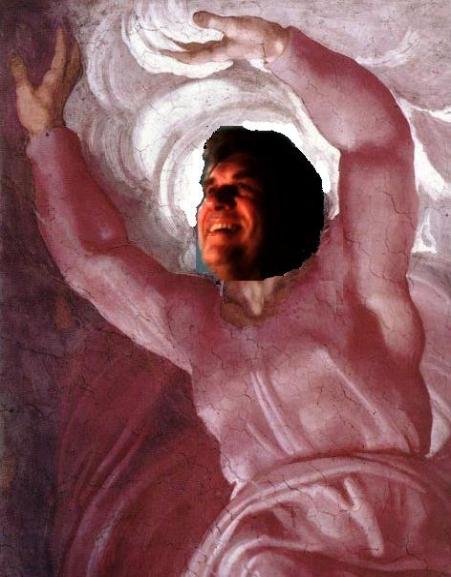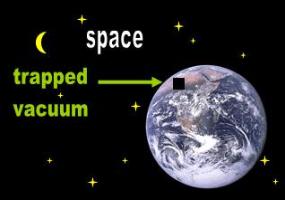| Adapted for the Internet from: Why God Doesn't Exist |
1.0 How relativists drag holes around: the movie
Let’s assume that we evacuate a chamber completely of all its contents? There are now no more atoms inside the chamber;
just empty space. We can now boast that we have ‘trapped’ a volume of space inside our little chamber. We have sliced a
chunk of space away from space. This space cube is everywhere in the vicinity surrounded by regular matter: the chamber
walls, the air surrounding the chamber, us, the Earth, etc. (Fig. 1). We now put this chamber on wheels so that we can roll it
from location A to location B. The million-dollar question is whether the space at B is the same space we had at A or
whether B constitutes a new ‘volume’ of vacuum.
| The Universe is a binary system: space and matter |


| I think I'm going to have to separate space from matter. Relativists keep confusing them all the time! |
- This module: After 3000 years, the idiots of Mathematics cannot tell you what space is
Pages in this module:
1. In Mathematical Physics, space is a physical object
2. Relativists say that space is both finite AND infinite
- 3. What properties does space really have?
4. This page: The Universe is a binary system: space and matter
5. The First Rule of Physics
- Space-warpers and the lamebrains who designed GPB will argue that this vacuum moves along with the chamber. Their
reasoning is probably that if space is a structure that can be warped, this implies that it can be handled, cut, and transported
like a piece of meat.
Intuition tells us that space is made of nothing and that we have made a window, a cutout in matter. As the
Earth revolves around the Sun, we see empty space through this cutout no differently than if we had mounted our chamber
on a spinning carousel in outer space. Our wheeled chamber is on a merry-go-round encountering ‘new space’ as the Earth
spins like a top. For a moment we had the illusion of trapping a chunk of space and dragging it with us, when in fact the
space we boxed-up slipped right through our fingers.
2.0 The day relativists boxed space
Assume now that you are an astronaut in outer space holding a box having a length of one meter per side. Upon sealing
the lid you enclose one cubic meter of space. Now you approach the ship to show your commander the space you trapped.
Do you believe that you moved the initial volume of space or did this space slip unnoticed through the box? Did the box
capture a pound or so of vacuum or was the box trapped all along within space? Did void escape when you opened the
box to show it to your commander? Was it replaced by new space? Does empty space move like the air you breathe?
Would you conclude that there are subatomic particles of space swirling around?
Well, get ready for a startling answer to these questions. That’s exactly what the brightest experimental and theoretical
mathematicians have determined.
- " According to quantum field theory, empty space actually consists of varying
electro-magnetic fields." [1]
- This is the ridiculous state of ‘Physics’ today. A rational person concludes, rather, that matter cannot contain space; it is
space that contains matter. We don’t need any experiment from NASA or from SLAC to ‘prove’ this, or a theorist from
Cambridge to tell us that he derived this correct and verified notion from an impeccable equation. The astronaut thought
he caught a leprechaun when in fact the leprechaun had the astronaut in the bag all along.
While you are still out there in orbit, let’s do a second experiment. Turn on your flashlight and point it at space. Do you
see scattering of light, or reflection, or refraction? If space were made of particles, as relativists and mechanics suggest,
light would have something to bounce against and produce these effects. Sound would also be propagated through the
particles of space. Experiments demonstrate exactly the contrary. Here we see that intuition and common sense are
incomparably superior to Mathematics when it comes to elucidating Physics. Mathematics is absolutely worthless in
this context!
3.0 How many relativists does it take to contain space?
Let’s now transform ‘thought’ into a physical entity and assume that it either leans against or contains space as
illustrated in Fig 2. (I use thought because it is one of the example most often given by laymen attempting to imagine
the unimaginable next dimension.) The scenario implies that thought is to space what oil is to water. For some physical
reason neither can encroach into the other’s domain.
However, if this were true it would outlaw thought from our Universe. Note that the same would result if time, a dimension,
or whatever is used in lieu of thought. Anything we can conceive to exist cannot serve as a barrier to space because
otherwise we wouldn’t conceive of its existence. We would not have any examples of this magical substance within our
Universe. Certainly, we do not see an entity displacing space in our vicinity. Hence, we are forever denied the ability to
test such an entity because we cannot even imagine it.
Fig. 1 A hole in matter, or transporting space? |
Fig. 2 Food for thought |
| Mathematics has no power to elucidate what could contain the Universe. This is strictly a conceptual issue. We can conceive of thought containing space only if both thought and space have shape. But then, what gives shape to thought? The mathematicians suggest that a higher dimension perhaps contains space. So what do they mean? Does it make sense to say that height contains Flatland? What contains the 26th Dimension? Breadth? |

| If we could attain perfect vacuum in a chamber, is the Earth then transporting this cutout of cosmic space around during its orbit? Have the technicians ripped a chunk of space from the cosmic ocean? Or are we seeing new volumes of space through the window as the Earth moves? |
This ‘thought’ gedanken experiment is not a total loss, however, because it helps us zero in on the nature of space. What
is it about thought that has the ability to contain space in Fig. 2? Can matter drift beyond the space border into a pure
thought region? Does an object continue to have shape once it departs space? Does the thought region also have an
end? What contains it?
My line of reasoning leads me to an important conclusion. In order for you to make any sense of Fig. 2,
you must regard both space and thought to have borders. Only then can you conceive of thought coming up against
space. And this reinforces and is consistent with the definition of object. We can only use the word object consistently
in a scientific discussion if we define it as ‘that which has shape.’ But then, if space is not an object, we have identified
its most important property:
- space: That which lacks shape.
Space is a place. It is not a what, but a where. Space is the antithesis of the word object. We cannot contain space with
a physical entity or medium (vacuum chamber, astronaut box, etc.) or with a concept (thought, dimension, etc.) because
there is nothing to contain. We cannot escape space because there is no boundary to cross. These statements are
consistent with the intuitions of some of our mathematicians:
- “ if space is expanding, into what is it expanding? Isn’t there somewhere that it spills
over? The answer is no.” (pp. 80 – 81) [2]
“ ‘The boundary condition of the universe is that it has no boundary.’ The universe
would be completely self-contained and not affected by anything outside itself.”
(p. 136) [3]
Not even almighty God can escape space, for else He would lose His most precious attribute: shape. Without shape,
God is absolutely nothing (i.e., space)!
It could be argued that space is just another concept, but this proposal is easily debunked. Space and
concepts are alike in that they don’t have shape, yet they differ in that concepts are artificial. Humans created every
single concept that you are aware of including God and space-time. Space was there before any of us came around.
Nevertheless, what sense does it make to say that we live within a concept (i.e., invented by Man)?
4.0 The First Law of Physics
Since the 17th Century binary algebra has slowly grown to challenge the monopoly of the decimal system. Unlike decimal
numbers, which are represented by ten different symbols, binaries consist entirely of zeroes and ones. The digital nature
of binary format makes it an ideal system of numbers for decision making, which is why its use has been adopted in
computing. For the purposes of this page, it is worth reviewing how a chip converts electric signals to numbers so that
we can extrapolate the analogy to space and matter.
A microprocessor, the brain of a computer, consists of thousands of transistors laid out in neat grids of rows and columns
called arrays. Aluminum and silicon lines interconnect transistors in the array and supply them with current. Each transistor
functions as a switch by acquiring a discrete value of either a one or a zero. If both lines supply a high voltage current, the
transistor is read as a one. If either line sends a low voltage current, the transistor does not reach a specified voltage and
it is read as a zero. A series of transistors combine these two states to create letters and numbers by representing them in
binary format. Although to the layman computers seem to work by art of magic, the calculations they perform and the
sounds and images they produce are the result of physical connections and logical processes.
The human brain works quite like a computer microprocessor although it is a bit more complex. Rather than an array of
transistors we find inside the brain a web of cells called neurons interconnected by gaps called synapses. Information in
the form of electrical charges is transmitted from the axon of one neuron via a synapse to the dendrite of another neuron
where that information is converted into chemical signals. Because the brain and the microprocessor are entirely made
of atoms, ultimately, the intangible mechanism we call thought or memory or calculation are the result of the movement
of some type of matter. It would not be too far fetched to speculate that the brain's "microprocessor" also uses the binary
system to produce mind and soul. This, of course, is speculation.
Last, but not least, our Universe is also a binary system explainable in terms of rational physical mechanisms. The Universe
consists of two complementary components, matter and space, the yin and the yang so to speak, the one and the zero. In
the binary system, a one can be added and subtracted and carried over. For example the number 2 can be obtained by
adding two number ones as follows:
- Binary Decimal
Position > 32 16 8 4 2 1
0 0 0 0 0 1 = 1
+ 0 0 0 0 0 1 = 1
_____________ ___
In other words, a one plus a one equals a zero, but we carry a one over to the adjacent position, which is the twos column.
Similarly, two plus two is expressed as follows:
- Binary Decimal
Position > 32 16 8 4 2 1
0 0 0 0 1 0 = 2
+ 0 0 0 0 1 0 = 2
_____________ ___
- Again, a one plus a one in the twos column is added, a zero is placed below the line, and a one carried over. Notice that the
action figure is the number one. It changes places while place itself remains immobile. Numbers flow endlessly as if in
motion, but location acts like a board on which numbers are drawn. Position is static, immutable. Unlike the one, which
represents a number, a zero represents a location. The zero’s purpose is not to participate in arithmetical operations, but
to serve in a positional capacity. For the purposes of Science, zero is not a number. It cannot be added, subtracted,
multiplied or divided like other any of the other numbers. Zero is strictly a place holder: positional notation. Zero is a place
where we are going to put a number. And when the number barges in, it does not displace a zero. A zero has no way of
interfacing with a number any more than space can interact with matter. The zero is a character used to express the
absence of numbers. Even in the decimal system we will always have 'something' regardless of how small we imagine
our fraction to be. Zero, instead, represents the absence of numbers. A zero means that the slate has been wiped clean.
In fact space is more restrictive than the magical zero of abstract Math. In Math we can do almost anything, such as subtract
one from one to produce zero. In the real world cancellation of matter and ‘anti-matter’ does not result in space, but allegedly
in 'energy.' Space is neither energy nor process. Processes find a parallel in mathematical operations, not in the symbol zero.
Matter and motion are entirely unrelated to space.
Like position, space is motionless. Space is to position and zero what matter is to number and one. A one can be divided
into seemingly infinite fractions and never become a zero. Similarly, matter can be divided into countless pieces, but never
become space. Fractions of matter are scattered throughout space and, if added up, they could be conceived to constitute
a single block of matter. The Law of Conservation of Energy requires that the physical account be balanced in the end. It
states that in any closed system the amount of energy is constant or, in other words, that energy cannot be created nor
destroyed. If space cannot be contained, the Universe is a closed system, and if mass and energy are different states of
matter, they can be converted from one state to the other, yet never allowed to vanish (i.e., to leave the boundary of space
or be converted to space). Matter has nowhere to disappear into. In light of the fact that matter and space are complementary
components of the Universe, I will restate the Law of Conservation of Energy in its correct form and label it the First Law
of Physics:
- The First Law of Physics
- Matter cannot be converted into space nor space into matter.
The nature of matter and space makes them complementary. This realization has the interesting implication that the amount
of matter in the Universe does not vary. Matter cannot be created from space or space from matter, and matter cannot leave
space because space has no boundaries to cross. Not even God can escape that which has no boundaries!

| Let’s play a game. I pick a dimension and you think of the one that encloses it. At some point, the mathematicians will have to confront the question they routinely shove off to philosophers. A relativist has to answer what contains space or the last dimension he can imagine. This is a sine qua non part of THEIR theory. Without it, they have nothing. Relativists like to treat space as a physical object (when they say it is finite) and as nothing (when they say that it is unbounded). What encloses space (or space-time)? Nothing! Or better yet, they claim that it is unfair to ask the question. How self-serving! The only way to resolve this issue is by assuming that space is not contained. This makes it clear that space cannot possibly be a physical object as relativity holds. |
- ________________________________________________________________________________________
- Copyright © by Nila Gaede 2008
